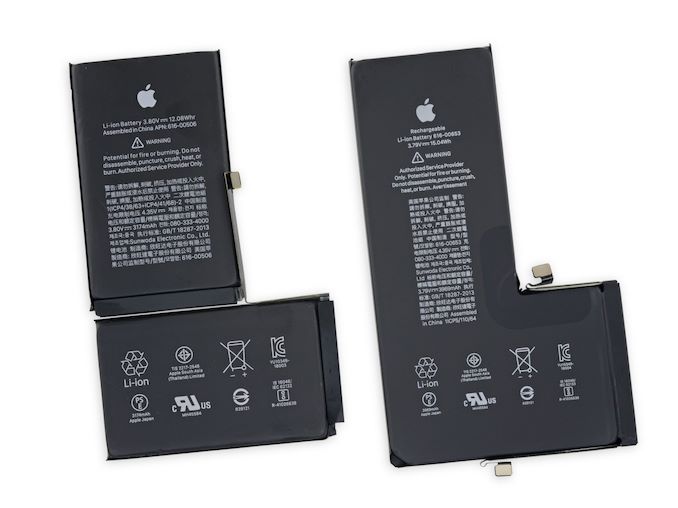The Apple iPhone 11, 11 Pro & 11 Pro Max Review: Performance, Battery, & Camera Elevated
by Andrei Frumusanu on October 16, 2019 8:30 AM ESTBattery Life - A Magnitude Shift
By now many will have heard positive things about the new iPhone 11s' battery life. As we have covered in the introduction, possibly the biggest changes to Apple’s line-up this year is the device’s vastly increased battery capacities. The Pro models in particular have seen significant increases: the 11 Pro gets a 3046mAh battery which represents a 14.5% increase compared to the XS, and the 11 Pro Max gets a 3969mAh battery which represents a very large 25% increase. The Pro Max is now the first Apple device which has a battery capacity comparable to Android phones out there, some of which have offered similar large capacities for a few years now.

iPhone XS Max vs. iPhone 11 Pro Max Batteries (Image Courtesy iFixit)
The regular iPhone 11 sees only a 5.7% bump to up to 3110mAh, which isn’t all that big upgrade compared to the XR. But it also doesn’t increase its weight nearly as much as the Pro models.

The battery results in our web test are outstanding. Apple in this generation has gone from being average in battery life to showcasing some of the best results we’ve seen in the market.
What is very interesting here is how our absolute test runtimes end up compared to Apple’s marketing claims. Apple has promised +1H, +4H and +5H of battery life for the 11, 11 Pro and the 11 Pro Max compared to their predecessors, and what we measured is 1.08H, 3.9H and 5.27H, which is pretty damn near Apple’s promoted figures, pointing out to some very similar testing conditions between our test and Apple’s internal metrics.
If we break this down a bit and theorize a bit, if we take the XS Max 10.31H result, multiply by 1.25x for the increased battery capacity (12.88H), multiply again naively by 1.15x for the more efficient screen (14.82H), we’re left with a ~5% margin which would account for the more efficient SoC. Give or take margin of error here or there, the results we’re seeing shouldn’t be all too surprising. The math would also check out for the iPhone 11 without a newer display: 5% increased battery capacity and an on average ~3% more efficient SoC.
There’s not much to say about the new iPhone 11 series' battery life other than it's exemplary. More importantly, Apple has managed to finally catch up and exceed the battery life of the LCD iPhone 8 and Plus models from 2 years ago.










242 Comments
View All Comments
UglyFrank - Wednesday, October 16, 2019 - link
I really did not need to see those T Rex scores, it hurt me spirit as a lifetime Android Phone user.My S4 would get 17fps in T-Rex and the iPhone is getting ~16-19x that after only 6 years later.
Death666Angel - Wednesday, October 16, 2019 - link
"only 6 years later" Heh.Pro-competition - Wednesday, October 16, 2019 - link
Why was there no storage performance test? This affects app loading times (esp since Apple doesn't have much RAM), and app installation times, which affect real-world performance.Andrei Frumusanu - Wednesday, October 16, 2019 - link
We're lacking a better test that works properly. I prefer to skip it rather than have misleading figures.Pro-competition - Wednesday, October 16, 2019 - link
Understood. Instead of synthetic benchmarks, perhaps just have a table of app loading times of some games? What I have in mind is the following:1. Compare current iPhones with the previous generations of iPhones (maybe just go two generations back). And use iPhones with different storage capacities.
2. Ensure all iPhones have the same iOS version.
3. Select ~5 games for your test suite, ensuring that the same version is installed on all iPhones.
4. Before loading the game, close all apps and then restart the phone, so that when the game is launched, we can be assured that are no apps already running.
5. Do step 4 around five times.
6. Use a video recorder to measure the time.
What do you think of my proposal?
masimilianzo - Wednesday, October 16, 2019 - link
Great review, thanks!Any idea on LD/ST bandwidth? Have they increase the number of AGUs?
Andrei Frumusanu - Wednesday, October 16, 2019 - link
Bandwidth is included in one of the charts. It looks unchanged, and I didn't see anything different on the instruction side either.masimilianzo - Wednesday, October 16, 2019 - link
Are you measuring number of ports in the L1 RAM or number of address generation units?I guess it depends on having or not conflict to read ports in the RAM.
The large uplift in h264 test in SpecInt2k6 could come from an additional LD pipe..
willis936 - Wednesday, October 16, 2019 - link
"To be sure, this isn’t the very time we’ve seen this, as OnePlus, LG and Google have already introduced it in their phones over last year."very *first
eastcoast_pete - Wednesday, October 16, 2019 - link
Andrei, thanks for your review! One question/request, both for this iPhone review, but also future phone reviews:. Please test the call quality and reception (especially in challenging situations with a single bar/ low signal strength)! I found a couple of otherwise very attractive smartphones fall flat on their phone function. Since my mobile is my main phone, which I also need for work, call quality is a non-negotiable. Unfortunately, even your otherwise excellent reviews skip that aspect. So, any words on call quality of the new iPhones? Thanks!